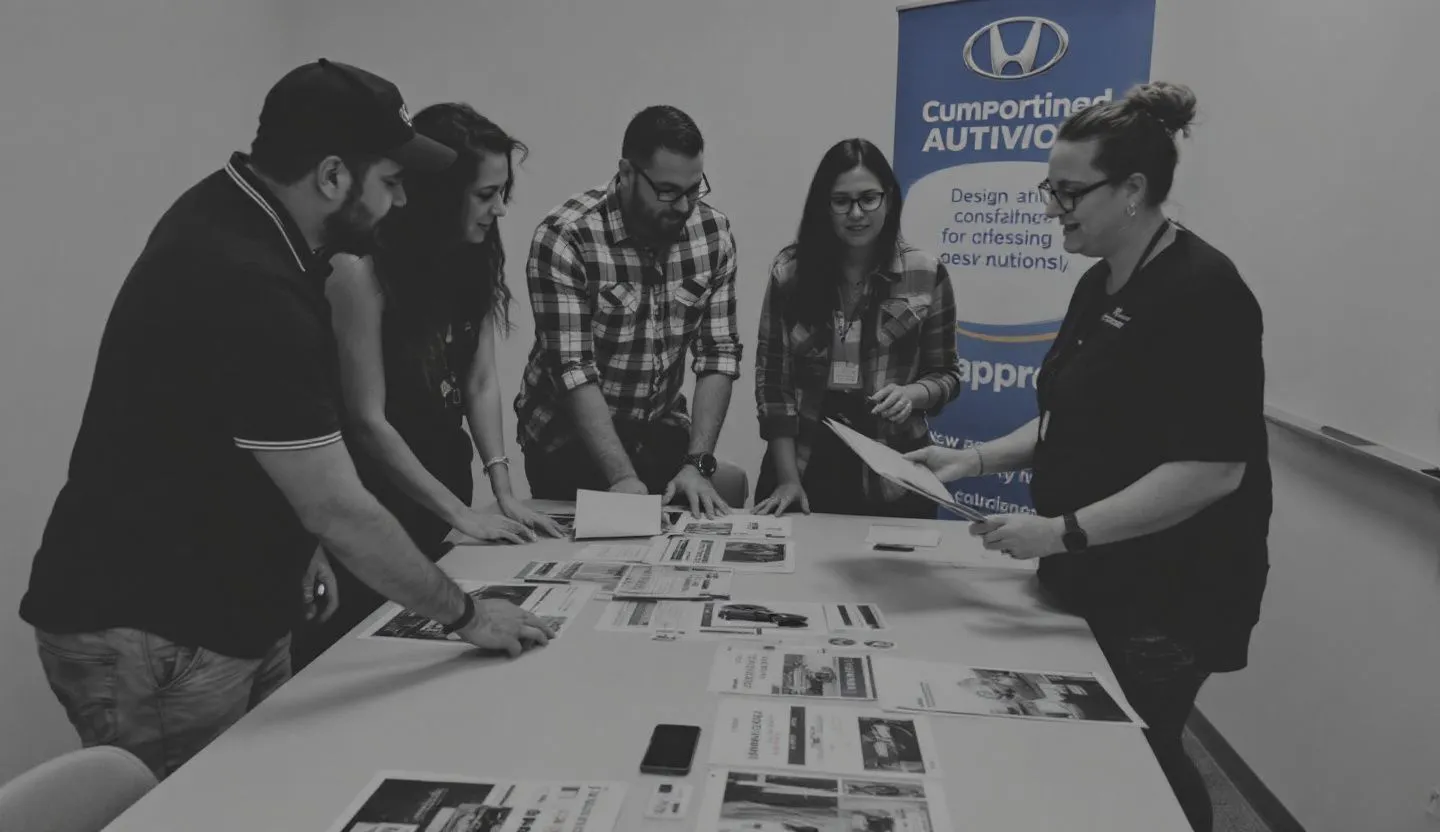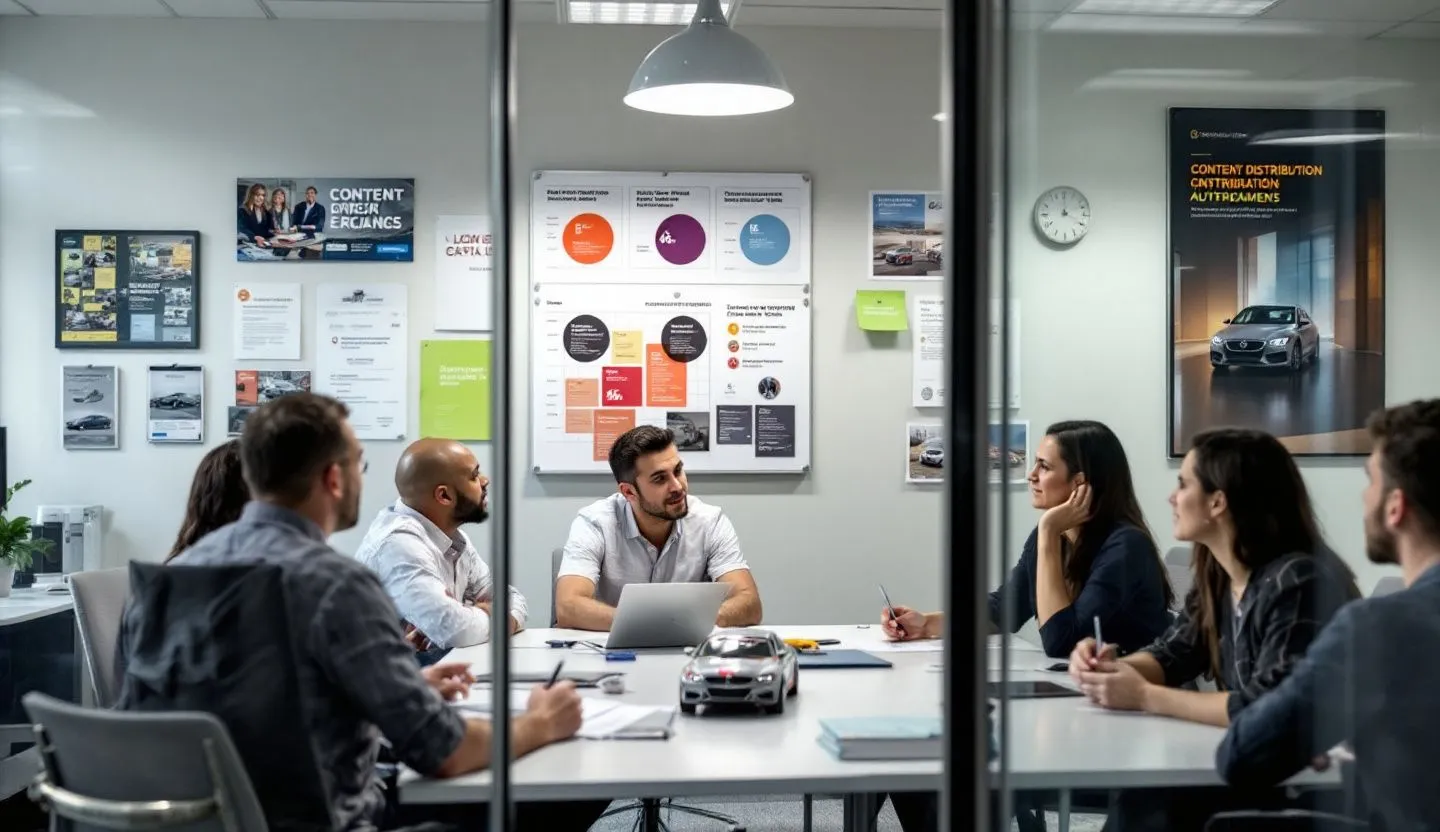There’s a moment every automotive marketing leader knows: the product launch window is closing, the clock is ticking, and your teams are scrambling to localize 40+ pieces of content for 12 different markets,all while legal is pinging you about a last-minute compliance update. Your inbox is a firehose, your teams are swamped, and the risk of an off-brand slip or outdated asset is suddenly very, very real.
This isn’t a one-off. It’s the daily tension of modern automotive content operations,where the expectation is always “do more, do it faster, and don’t break the brand.” Meanwhile, budgets tighten, headcount freezes, and every manual touchpoint becomes a cost and a risk.
If you’re a CMO, Head of Brand, or Marketing Ops Director in automotive, you’ve lived this. You’ve watched your teams burn hours on version control, compliance checks, and asset localization. You’ve seen brilliant creative get stuck in email purgatory, or worse, go rogue in the wild, breaking brand standards you fought hard to build.
The stakes are rising. Content isn’t just a cost center,it’s the fuel for growth, reputation, and customer experience. But how do we future-proof these operations to be truly scalable, compliant, and cost-efficient? How do we shift from firefighting to forward-thinking?
The growing complexity of automotive content operations
Let’s talk about why content ops in automotive are uniquely tough. Our industry lives at the intersection of regulation, innovation, and hyper-localization. Global brands must speak with a single voice across hundreds of touchpoints,yet adapt that voice for regional legal nuances, language, and dealer needs.
Think of a typical campaign rollout:
- A new EV model is launching in 30 countries: Each region requires unique pricing, imagery, and disclaimers.
- Assets must pass through marketing, legal, compliance, and sometimes even product and IT: Final files need to land in the hands of hundreds of dealerships, each with their own sales priorities and local adaptations.
The result? A sprawling ecosystem of content, with assets scattered across cloud drives, local desktops, and email threads. The risk of error is high,think outdated lease terms, non-compliant claims, or inconsistent branding. And every manual step, from asset handoffs to version checks, adds delay and cost.
The pressure is relentless: new channels, new compliance rules, and growing demand for hyper-personalized content at scale. For many teams, the cracks are already showing. Missed deadlines, spiraling costs, and brand dilution aren’t just theoretical,they’re today’s reality.
Why traditional processes are reaching a breaking point
For years, most of us relied on a familiar toolkit: email, spreadsheets, PDFs, maybe a DAM (digital asset management) system or a shared drive. It worked,until it didn’t. The volume, speed, and complexity of modern automotive content operations have outgrown these tools.
A few years ago, I watched a global campaign stall for days because a single legal disclaimer update had to cascade through 100+ asset variations, each managed in its own folder. The result? Overtime, errors, and a legal headache when an outdated offer slipped through. This isn’t an edge case,it’s how many of us still operate.
The “hidden costs” of these manual processes are staggering. Consider:
- Time lost to asset hunting: Teams waste hours searching for the latest version or re-creating assets they can’t find.
- Compliance risk: Out-of-date claims or missing legal language can trigger costly fines or recalls.
- Brand inconsistency: Rogue edits or ad hoc localization break the brand experience, eroding trust.
- Inefficient collaboration: Creative, legal, and marketing teams get stuck in endless feedback loops, slowing speed-to-market.
The worst part? These inefficiencies scale as you grow. The more markets, channels, and campaigns you add, the more the cracks widen,unless something changes.
How the landscape is shifting for automotive content leaders
The good news: the pain points are driving real change. Enterprise automotive brands are reimagining their content operations, not just to cut costs, but to enable true scalability and resilience.
Several forces are accelerating this shift:
- Increased regulatory scrutiny: From emissions claims to digital accessibility, compliance is more complex than ever. Fines are steeper, and the reputational risk is existential.
- The rise of omnichannel retail: Customers expect seamless experiences across web, mobile, social, and in-dealership touchpoints,each requiring tailored, up-to-date content.
- Pressure to do more with less: Budget freezes and talent shortages mean teams must scale output without scaling headcount.
- The pace of innovation: New models, EVs, and digital retail formats demand faster, nimbler campaign execution.
I’ve seen brands pivot from reactive, manual workflows to integrated, automated solutions that centralize control without sacrificing local agility. This isn’t just about technology,it’s about rethinking how people, process, and platforms work together.
Building a future-proof content operation in automotive
The goal isn’t just to “fix” today’s process. It’s to design an operation that can flex and scale,whether you’re launching a new model in Tokyo, updating disclaimers in Texas, or enabling dealers in Berlin to personalize their point-of-sale materials.
So what does a future-proof automotive content operation actually look like? At its core, it’s:
- Centralized but flexible: One source of truth for brand assets, guidelines, and templates,adaptable for local markets, dealers, and compliance needs.
- Automated where it matters: Smart workflows that route assets for review, automate localization, and flag compliance risks before they go live.
- Seamlessly collaborative: Marketing, creative, legal, and IT working in sync, with clear roles and transparent feedback loops.
- Secure and compliant: Enterprise-grade security, audit trails, and role-based access that satisfy legal and IT standards.
- Scalable by design: Able to support rapid growth, new channels, and evolving business models,without breaking under pressure.
Let’s unpack what this looks like in practice, and how it reduces cost and complexity at every stage.
Centralizing brand assets for consistency and speed
Imagine a world where every dealer, marketer, and creative partner can access the latest, approved assets instantly,no more digging through email chains or risking outdated files. This is the promise of a centralized content hub.
Centralization isn’t just about storage,it’s about control. When you house templates, brand guidelines, and legal-approved language in one place, you eliminate the “version roulette” that plagues so many teams. Updates cascade instantly, and compliance is built-in, not bolted on.
A global automotive brand I worked with recently moved all their campaign assets,digital, print, and POS,into a unified platform. The result? They cut asset search time by 60%, reduced duplication, and slashed errors from outdated files. Dealers could self-serve localized materials, while HQ retained oversight.
This approach delivers real cost savings (fewer manual updates, less rework) and real peace of mind. Brand consistency stops being a daily firefight,and becomes the default.
Automating workflows to reduce manual effort and risk
Automation is the engine room of scalable automotive content operations. It’s not about replacing people,it’s about freeing them from the repetitive, error-prone tasks that slow everything down.
Workflow automation can take many forms in automotive marketing:
- Automated review and approval: Assets route automatically to legal, compliance, or brand teams. Feedback is tracked, and only the latest, approved versions move forward.
- Smart localization: Templates allow for easy swapping of regional offers, pricing, and imagery,without manual re-design or risky copy-paste jobs.
- Compliance monitoring: Built-in checks flag missing disclaimers, outdated terms, or non-compliant language before assets go live.
One automotive group automated their legal review process for campaign assets. Instead of weeks of back-and-forth emails, the workflow surfaced only the sections that changed,cutting legal review time by 70%. Marketers got to market faster, and legal teams had a clear audit trail for every approval.
Automation doesn’t eliminate the need for human judgment,but it does make sure people focus on high-value work, not chasing down signatures or formatting copy.
Empowering local teams without losing control
The best automotive brands win locally, not just globally. But empowering dealers and regional marketers is a double-edged sword: give too much freedom, and you risk brand chaos; too little, and you slow down sales.
A future-proof content operation balances this tension with smart templating and permissions:
- Templates provide a “safe sandbox:” Dealers can localize offers, swap in relevant imagery, or adjust pricing,within guardrails set by HQ. Brand fonts, logos, and legal language are locked down.
- Role-based access ensures compliance: Only authorized users can edit core brand elements, while local teams can adapt what matters most to their market.
- Usage analytics give HQ visibility: See who’s using which assets, where, and how,so you can spot gaps or risks before they become problems.
A leading European OEM enabled their dealers to customize digital banners and print flyers via a self-service portal. HQ set the templates and legal copy; dealers could add local offers or contact info. Compliance risk dropped, brand consistency soared, and dealer satisfaction skyrocketed.
This model turns content ops from a bottleneck to a growth engine, giving teams the tools to move fast,without going off-brand.
Integrating compliance and security into every step
Compliance isn’t a checkbox,it’s a core business risk, especially in automotive. From advertising disclosures to data privacy, the cost of getting it wrong can be existential.
Embedding compliance and security into your content operation means:
- Real-time legal updates: When regulations change, updates push instantly across all templates and assets,no more manual chasing.
- Audit trails and reporting: Every change, approval, and distribution is logged, satisfying legal, IT, and risk teams.
- Secure, enterprise-grade platforms: SSO, role-based permissions, and encryption protect sensitive assets and customer data.
I’ve seen legal and risk teams go from “blockers” to “partners” when given transparent tools and clear audit trails. Instead of panicked fire drills, they enable speed,confident that every asset in market is up-to-date and compliant.
The result? Reduced risk, happier stakeholders, and a business that can move at the pace the market demands.
Collaborating across teams for faster speed-to-market
Great automotive content doesn’t happen in silos. It’s the product of creative, marketing, legal, IT, and dealer teams working in sync. But too often, collaboration is a byword for endless meetings, scattered feedback, and lost momentum.
Modern automotive content operations bake collaboration into the process:
- Live, in-platform feedback: Stakeholders comment directly on assets, reducing email overload and miscommunication.
- Transparent status tracking: Everyone sees where an asset is in the workflow,no more “where’s that file?” drama.
- Clear roles and responsibilities: Automated workflows assign tasks, reminders, and deadlines, so nothing falls through the cracks.
A North American auto brand replaced its patchwork of email threads and shared drives with a single, collaborative content platform. The time from creative brief to in-market asset shrank by 40%. Teams spent less time chasing approvals and more time optimizing campaigns.
The upshot? Collaboration stops being a drag on speed-to-market and becomes a competitive advantage.
Measuring impact and optimizing for continuous improvement
Future-proofing isn’t a one-and-done project,it’s a mindset. The best automotive marketing teams treat their content operations like a product, constantly measuring, learning, and optimizing.
Key metrics to track include:
- Time-to-market: How long from brief to live asset? Where are the bottlenecks?
- Asset utilization: Which assets get used, adapted, or ignored? What’s missing?
- Error and compliance rates: How often do assets need rework? Where are the risks?
- Cost per asset: What’s the total effort (people, time, money) to get an asset in market?
By surfacing these insights, you can spot what’s working, what’s not, and where to invest next. One automotive group cut their cost per campaign by 30% after identifying redundant workflows and underused assets.
Continuous improvement isn’t just good practice,it’s what keeps your operation scalable as the landscape evolves.
Real-world examples: Automotive content operations in action
Let’s make this real with a few anonymized but true stories from the field.
- Global EV launch, simplified: A major OEM needed to launch a new electric vehicle in 25 languages with unique offers per market. By centralizing templates and automating localization, they cut translation costs by 40% and slashed campaign lead time from eight weeks to three. Dealers were able to pull compliant, personalized assets directly from a self-service portal, boosting adoption and reducing manual errors.
- Compliance fire drill, averted: A national marketing team faced a sudden legal update: all lease advertisements needed new disclaimer language, effective immediately. With a cloud-based content hub, they pushed the update to every live asset,digital, print, and in-dealership,in hours, not days. No rogue ads, no fines, no late nights for the team.
- Empowering dealers, strengthening brand: An auto group with hundreds of franchise dealers struggled with inconsistent local advertising. By rolling out brand-locked templates and analytics dashboards, they improved brand compliance by 95% and gave dealers the flexibility to localize offers. The result? Faster market response and a unified customer experience, from website to showroom.
These aren’t just process wins,they’re business wins. Reduced costs, faster launches, and lower risk mean more resources for innovation and growth.
Future trends shaping automotive content operations
If we want to stay ahead, we need to look around the corner. Here’s what’s next for enterprise automotive content leaders:
- AI-powered content personalization: Dynamic creative tools will auto-tailor messaging for audience segments, reducing manual work while increasing relevance.
- Deeper integration with martech stacks: Content platforms will plug directly into CRM, analytics, and dealer management systems, creating seamless data flows and smarter reporting.
- Adaptive compliance: Real-time monitoring and AI-driven risk alerts will spot potential compliance issues before they hit the market.
- Sustainable content ops: As ESG and sustainability rise in importance, expect content workflows to optimize for digital-first, reducing print waste and carbon footprint.
- Dealer enablement at scale: Self-service, brand-safe portals will empower dealers and partners to adapt assets instantly,without risking compliance or consistency.
The future is less about more tools, and more about smarter, more connected operations. The brands that win will be those that treat content ops as a strategic asset, not a tactical afterthought.
Future-proofing automotive content operations isn’t just a nice-to-have,it’s a business imperative for brands navigating complexity, compliance, and cost pressures. As marketing leaders, we know the pain of legacy workflows: the late nights spent tracking down approvals, the brand slips that keep you up at 2 a.m., the spiraling costs of manual rework. But we also know the thrill of a campaign that lands flawlessly, at speed, across every market and channel.
The shift is clear. By centralizing assets, automating workflows, empowering local teams, and embedding compliance at every step, we build content operations that scale with us,not against us. It’s about more than technology; it’s about creating a culture of clarity, collaboration, and continuous improvement. When we future-proof our content ops, we unlock time, reduce risk, and free our teams to focus on what matters: building a brand that wins trust, drives sales, and shapes the future of mobility. As the automotive landscape evolves, so must we,turning operational pain into competitive advantage, one campaign at a time.







